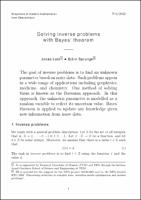| dc.contributor.author | Latz, Jonas | |
| dc.contributor.author | Sprungk, Björn | |
| dc.contributor.editor | Houston-Edwards, Kelsey | |
| dc.contributor.editor | Singh, Anup Anand | |
| dc.contributor.editor | Randecker, Anja | |
| dc.date.accessioned | 2022-09-05T11:49:35Z | |
| dc.date.available | 2022-09-05T11:49:35Z | |
| dc.date.issued | 2022-09-05 | |
| dc.identifier.uri | http://publications.mfo.de/handle/mfo/3972 | |
| dc.description.abstract | The goal of inverse problems is to find an unknown parameter based on noisy data. Such problems appear in a wide range of applications including geophysics, medicine, and chemistry. One method of solving them is known as the Bayesian approach. In this approach, the unknown parameter is modelled as a random variable to reflect its uncertain value. Bayes’ theorem is applied to update our knowledge given new information from noisy data. | en_US |
| dc.language.iso | en | en_US |
| dc.publisher | Mathematisches Forschungsinstitut Oberwolfach | en_US |
| dc.relation.ispartofseries | Snapshots of modern mathematics from Oberwolfach;2022-06 | |
| dc.rights | Attribution-ShareAlike 4.0 International | * |
| dc.rights.uri | http://creativecommons.org/licenses/by-sa/4.0/ | * |
| dc.title | Solving inverse problems with Bayes' theorem | en_US |
| dc.type | Article | en_US |
| dc.identifier.doi | 10.14760/SNAP-2022-006-EN | |
| local.series.id | SNAP-2022-006-EN | en_US |
| local.subject.snapshot | Numerics and Scientific Computing | en_US |
| local.subject.snapshot | Probability Theory and Statistics | en_US |
| dc.identifier.urn | urn:nbn:de:101:1-2022112209270328668198 | |
| dc.identifier.ppn | 182315963X | |


